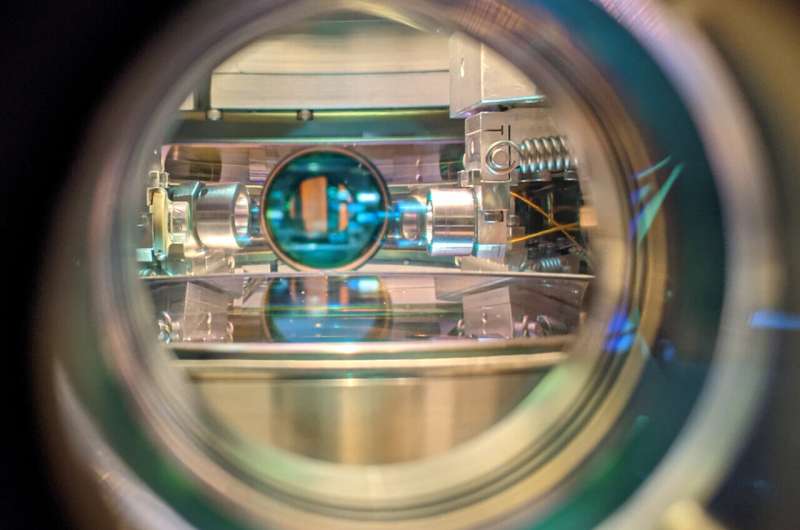May 1, 2024 feature
This article has been reviewed according to Science X's editorial process and policies. Editors have highlighted the following attributes while ensuring the content's credibility:
fact-checked
peer-reviewed publication
trusted source
proofread
Generating graph states of atomic ensembles via photon-mediated entanglement

Graph states, a class of entangled quantum states that can be represented by graphs, have been the topic of numerous recent physics studies, due to their intriguing properties. These unique properties could make them particularly promising for quantum computing applications, as well as a wider range of quantum technologies.
In a canonical graph state, each vertex of a graph represents an individual qubit (quantum bit), while the entanglement between these qubits is represented as the edges of the graph. The concept has also been generalized to states where quantum information is stored not in individual qubits but in continuous variables, such as the amplitude and phase of light.
While graph states have shown potential for enhancing some quantum information processing and quantum-based measurement tools, generating them for arbitrary graphs is challenging, as it requires a high level of control over the interactions that generate entanglement.
Researchers at Stanford University and the SLAC National Accelerator Laboratory demonstrate the generation of continuous-variable graph states of atomic spin ensembles, forming the vertices of a graph. Their paper, published in Nature Physics, opens new opportunities for the use of these states to realize new quantum computing and metrology systems.
"Our recent work fits into a broad effort to engineer entangled quantum states, in which information is encoded nonlocally in the correlations between two or more particles," Monika Schleier-Smith, senior author of the paper, told Phys.org. "These quantum correlations are the essential resource for envisioned quantum technologies ranging from quantum computers to ultra-precise sensors."
To be successfully deployed in real-world settings both quantum computers and ultra-precise quantum-enhanced measurement tools should be both scalable and easily programmable. In other words, they should be able to sustain entanglement between not just two but many atoms and should allow researchers to control correlations in the system.
The primary objective of the recent study by Schleier-Smith, her graduate student Eric Cooper, and their colleagues was to develop a method to entangle atoms that is both scalable and programmable. The method they developed entails the use of laser technology to control the entanglement between atoms in two or more subsystems.
"The primary experimental technique used in my lab is manipulating atoms with laser light," Schleier-Smith said. "Firstly, we use laser light to cool atoms to temperatures near absolute zero, and to form optical tweezers in which these atoms are trapped at the focus of a laser beam."
The researchers used four optical tweezers to position four clouds of atoms between a pair of mirrors, forming what is known as an optical resonator. This is essentially a 'box' that stores photons, allowing them to repeatedly bounce back and forth between the two mirrors.
"I think of the light inside the resonator as acting like a messenger that runs back and forth between the atoms and passes information between them—but, importantly, it does so secretly, without sharing the information with the outside world," Schleier-Smith explained. "That discreet sharing of information between the atom clouds allows them to become entangled."
Using their experimental method, the researchers were able to effectively engineer a four-mode square graph state. Their demonstrated approach thus promises to be both a scalable and efficient solution for programming the entanglement between quantum nodes and generating graph states.
"Naively, one might expect to need independent control of the interactions between each pair of nodes in the network to have full control of the structure of quantum correlations," Schleier-Smith said.
"This would be like having any two people in a social network be able to direct-message each other. However, we learned that a very broad class of entangled states can be prepared using only global interactions—like broadcasting a message to everybody in the social network—plus one added ingredient of local control of the individual nodes."
The recent study by Schleier-Smith and her research group could pave the way toward the widespread use of graph states for quantum computing and quantum metrology. In the future, their method could be used to prepare entangled states for specific applications, ranging from quantum error correction to quantum-enhanced sensing.
"In the near term, we are exploring applications to quantum-enhanced sensing and imaging—for example, how do we design quantum states that are optimized for recognizing particular spatial patterns in magnetic or optical fields?" Schleier-Smith added.
"In the longer term, we hope to extend our method of engineering entangled graph states to arrays of individually trapped atoms serving as qubits for quantum computation. This requires advances in the design of the resonator to enhance the strength of the atom-light interactions."
More information: Eric S. Cooper et al, Graph states of atomic ensembles engineered by photon-mediated entanglement, Nature Physics (2024). DOI: 10.1038/s41567-024-02407-1
Journal information: Nature Physics
© 2024 Science X Network





















